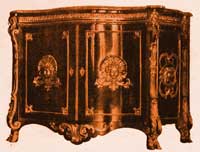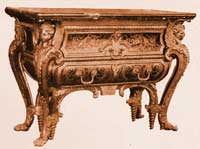Louis XIV Style
The Louis XIV Style is defining the long reign of the Sun King (1638-1715). The Treaty of Nijmegen confirmed France as a dominant power in Europe, and this position also favoured the dominance of French taste in arts. Paris set the fashion at the Court of Charles II in England, and for the whole Continent. Versailles became the symbol of the time.
The general impression of the Louis XIV furniture style is that of imposing majesty, more appropriate to stately rooms than to familiar living. It is the age of carved and gilded furniture, the period being named "the triumph of gilded wood." The exquisite ornamentation of the chairs frames, sofas, consoles or tables was certainly inspired by the work of goldsmiths.
In 1667, in a decisive move for the future of mass-art in France and Europe, Louis XIV established the "Manufacture des Gobelins", famous not only for the tapestries with the same name, but also for cabinet work, appointing the painter Le Brun as its head.
An extravagance of the Louis XIV style, now rare to find, is the massive silver furniture. It was initially introduced in France by Anne of Austria. It became very popular at court, and was later brought into England by Charles II. The richness and beauty of this type of furniture developed a taste for carved and gilded wood as a replacement, as not too many people could afford the silver version. As a result, in more modest houses and hotels the frames of the seats, mirrors, tables, and consoles were richly carved and gilded.

Chest - Louis XIV Furniture Style
Using dead and burnished gold, the craftsmen decorated the furniture with motifs like scrolls, guilloches, heavy foliage, lozenge-shaped imbrications embossed with flowers in high relief, shells and flowers. They were arranged as festoons, garlands, bouquets, and sheaves. Add the other popular motifs like the acanthus, the mascaron and the cartouche, and the effect will be a luxury and brilliancy that was unknown until the days of Louis XIV.
The furniture decoration was based on the rule that every piece of decorative work should consist of a combination of straight lines and curves. Another distinct feature of the Louis XIV style was a series of interlaced bars, or ending with scrolls. This combination is found also in the inlays of wood and brass and upon the walls of rooms, both painted and carved.
The bases and supports of the furniture are broad and rest firmly on the ground. The surfaces are broad, and have only few projections of detailed ornamentation casting shadows. Generally, the furniture is not high above the floor, except the armoires and beds. The colours are bold, the cornices resemble Roman capitals, while the tables are supported by massive columns or pilasters.
One of the distinctive styles of furniture at this period is that made by André Charles Boulle. Boulle's furniture is exclusively luxurious, it cannot “live” outside rich surroundings. It consists almost entirely of armoires, cabinets, tables, consoles, desks and clock cases. All these pieces present large surfaces on which Boulle’s decoration was carried to perfection. His designs are very heavy, and occasionally they take the curved, or bombe forms.

Chest of Drawers
Furniture Louis XIV
The frames of the seats, especially in luxurious apartments, were carved and gilt. They could be also painted in hues harmonized with the room tapestry.
The furniture executed in the Louis XIV style was richly upholstered. The chairs upholstery could be made of velvet, damask, brocade or tapestry As in the preceding periods, the upholstery was fastened to the seats by gold or silver-headed nails.
Sometimes lace was used to hide more ordinary nails, or a small lambrequin, or valance surrounded the frame of the seat, nearly reaching the floor.
Fringes were heavily used for chairs, stools and beds decoration. They were elaborate to the extreme, used in knots, twists, tassels, and headed by plaited and twisted braids.
For protection, pieces like sofas, chairs and folding chairs, as well as couches, had separate housses or slip covers that were generally made of taffeta.
The swelling curves and the complicated, lavish decoration of the Louis XIV furniture style gradually became finer, and more refined, transitioning into the next period.
